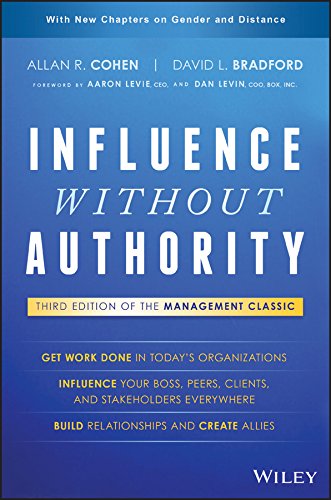Influence Without Authority

“Nobody has ever had enough authority – they never have and they never will.” It’s the first highlight in Influence Without Authority, and it is the defining statement for why we need to learn how to influence others without authority. Coercive influence is corrosive to relationships. It must be used sparingly when it is available, and it’s often not available. The fundamental message on how to influence through authority is through the law of reciprocity.
The Law of Reciprocity
In some circles, it’s known as tit-for-tat. (See The Evolution of Cooperation for more on tit-for-tat.) Fundamentally, it’s an awareness that when you do something good for someone else, they often feel a psychic debt to repay your kindness, generosity, trust, or material gifts. (For more on how trust is reciprocal, see Trust => Vulnerability => Intimacy, Revisited.) The power of reciprocity is so great that it’s worked its way into campaign and public service laws as well as the guidelines for many organizations. In its Latin form, quid pro quo is an ethical challenge and something that politicians and business leaders want to steer clear of.
In its smallest forms, the law of reciprocity may hardly be noticeable. You’re more inclined to hold a door for someone if you’ve had a door held open for you. Whether you hold the door for the person who held it for you or not, a single random act of kindness can set off a natural chain reaction of kindness that sends ripples in all directions for a long time.
The Model in Six Steps
The model for influencing with authority is six simple steps:
- Assume all are potential allies – Fundamental attribution error will drive us towards thinking the worst of other people, but we must fight the tendency. (See Thinking, Fast and Slow and How We Know What Isn’t So for more on fundamental attribution error.)
- Clarify Your Goals and Priorities – Get absolutely clear on what you want. We often confuse the means that we’re striving for with the ends that we really want. (See Who Am I? for more.)
- Diagnose the World of the Other Person – This is one part getting into the other person’s head – mind-reading – and one part finding their perspective. See Mindreading for more on getting inside the other person’s head. See Incognito and The Ethnographic Interview to understand perspectives and for tools for learning about the other person’s world, respectively.
- Identify Relevant Currencies: Theirs and Yours – “Currencies” here means motivators, things you can give them that they desire and vice-versa. Here, the work of Jonathan Haidt in The Righteous Mind and Steven Reiss in Who Am I? have illustrative of models for evaluating the other person.
- Dealing with Relationships – Here, the key is to relate to the other person. That takes a degree of emotional intelligence. (See Emotional Intelligence for more.) It also requires skills to carefully navigate difficult conversations. (See Crucial Conversations for more.)
- Influence through Give and Take – Here, the key is to give the other party what they want – and ask for the things that you want.
Being Heard
One of the most frequent causes of conflict and the reason that people resist influence is that they don’t believe they’ve been heard. They confront you with some concern that you quickly dismiss, and they feel as if you’ve not given it proper attention. It can be that it’s not applicable, but the summary dismissal makes the other person feel unheard, and that can create problems.
Helping other people be heard and understood – without necessarily agreeing – is a difficult art. It’s one that Miller and Rollnick discuss at length in Motivational Interviewing. They work with addicted individuals and convince them that their addiction is bad. Despite this, they must first develop a therapeutic alliance – a relationship through which they can say difficult things. (See The Heart and Soul of Change for more on therapeutic alliance.)
Our ability to communicate and read others’ minds may be the difference between us and other animals, but it also comes with an expectation. We’ve developed an expectation and need to be heard and understood. It’s something that we call need. (See The Righteous Mind and Mindreading for our ability to read others’ minds – and the evolutionary impacts.)
Hearing Objections
It’s too easy to dismiss objections and, when that doesn’t work, allow fundamental attribution error to kick in and think the worst of them instead of focusing on how their perspective or values are different. (See Thinking, Fast and Slow for more on fundamental attribution error.) It’s a starting point to acknowledge and learn more about the other person’s objectives. It’s advanced work to recognize that others aren’t bad people even if you struggle to understand their perspective.
With curiosity, you can begin to see objections and irritants as clues to the perspectives and values of the other person and thereby create a pathway to asking more questions and learning more.
Reality
Too often in our attempts to influence others, they bring their own version of reality that is difficult for us to hear. They see aspects of reality that we’d prefer to ignore. However, denying reality doesn’t make it less so. In fact, to deny reality makes it more dangerous for us, since we’re unable to respond wholly to the world around us.
Perhaps the best way to take a step towards the reality that we need to learn more about and get accomplished what you want through others is to read Influence Without Authority.
